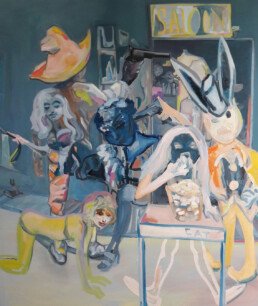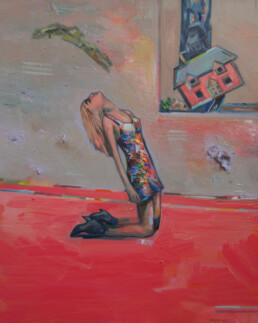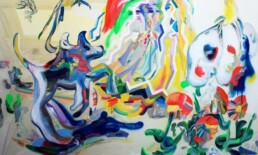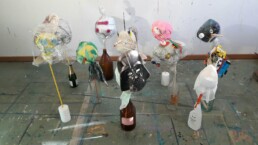Catalogue

Dowload the catalogue
The winsome, the mysterious, the spectral
notes on the fairytale elements in the work of Sofie Arfwidson by Dr. Gernot L. Thiele, Gemäldegalerie Berlin
To attribute the character of fairytale to something is a kind of challenge. Fairytaleness, mystery, spectrality – these are characteristics that reside in the emotional sphere. One naturally associates Sofie Arfwidson ́s work with Surrealism but I prefer to compare it directly to Felix Labisse ́s painting style and to call on him as the artistic authority. But what can I do to really do justice to the great sense of freedom in Sofie Arfwidson ́s paintings? Try to actually give a name to the mystery?
André Breton once said that the value of the real has to undergo a fundamental inquiry and therefore ”an artistic work must refer or hearken back to a purely internal model or it will eventually cease to exist.”
Attempting to give some kind of name to the internal model runs the risk of removing an artistic work from its traditional functional interrelationships. This assertion must then be immediately withdrawn or at least fundamentally revised because such functional interrelation- ships have always been somewhat contrived throughout the history of art; thus a situation is created in which, from today’s point of view, they must be both acceptable and unacceptable to us simultaneously – an audacious, if not untenable, thesis. When Sofie Arfwidson attempts to incorporate the magically mysterious into her work she is, to begin with, adhering to an artistic tradition of nonacceptance of function which holds that the mysterious itself is the actual expression of the artistic, the interior dialogue, the achievement of pictorial reality – paintings, in this case, that are enigmatic and that are able to evoke mysticality on their own.
Erotic moments are found in Sofie Arfwidson ́s work that are so profoundly rendered that they transcend the realm of so-called (ostensible) conventional love and can actually lead into a condition where fear takes hold. But then they have another simultaneous effect, one of providing us with a stunning beauty, an unmistakable tenderness emanating from the figurative representation. The lure of the seductive is almost tangible and I can almost smell the bouquet of the blossoms as they sway between the figurations. The delicacy, the painting, the brightness of the paint itself and the expressiveness that gives the impression of being sweet: these all come up against the dark side, coexisting with the haunted, the vividly rendered. It is all done by design. When considering the eroticism emanating from the paintings, two sides of this complex drive are represented, both the dark and the bright. An eroticism, a sexuality, that seeks to be just as thrilling as it is overpowering because it tries to serve as a transformative bridge – a ”yes” affirmation but also a ”not yet” or a ”not now”! I think that Sofie Arfwidson ́s paintings reach out and touch an excitability in us viewers that is meant to be a kind of permission granted.
Giving a name to the mystical and the unearthly can be done in two ways, which ultimately turns out to be one way when we are dealing with paintings. One considers the mystical as simply being a consequence of the pictorialness, the paint itself, the amorphousness, all those things that cannot be realized by clear, lineal means – we have found a term for this, which seeks in the history of art to describe this position: Expressivity. Everything that is pictorial entails the option of the mystical. Expressivity does not just mean a formal stylistic approach; expressivity wants to also be understood in a noetic sense. The mystical in this claim of noetical relevance may not, however, be really understood. What then? It must also be seen that there is a claim to historical meaning that also may be understood noetically. As in the artistic representation of the Judgment of Midas in the context of the competition between Apollo and the satyr Marsyas: the loveliness of the pastel colours of the paint offsets the seriousness of the theme especially considering that Marsyas, the loser of the competition, will subsequently be flayed. Actual gruesomeness is not really depicted in Sofie Arfwidson ́s paintings but are there allusions to it?
The stylistic demands summon the authority of a formal proposition: Expressivity and expressive depictions that lean in the direction of caricature. There is also the noetic element in the area of references that must be recognized, designed like an exposé of predictions from phantasms. The fairytaleness, the enchantedness, the magic can be described in the words of Heinrich Heine although, in the example, he is actually referring to a reversal of mood – his words nonetheless retain their relevance to our subject: ”… it was no longer just the powerful spell cast by the initial surprise, the fairytaleness, the completely uncanny emergence.”
When Sofie Arfwidson ́s paintings produce a sense of fright as well as a sense of the ghostly this momentary reaction of shock is counterbalanced by the beautiful pastel luminosity of the colouration. And the use of line in the composition – fiery, femininely open, will-o ́-the-wisp, wafting and seductive. But then, why such fiery brightness?
Because behind the loveliness everything that we imagine as being reality can go up in smoke. And reality itself? Or in this case the reality of the painting itself? What, pray tell, can the reality of the painting be at all? André Breton referred to an ”internal model”. Does every figurative conception predate something that we call memory and something that we connect of necessity with ideas about transformation – in the way that Ovid described in his ”Metamorphosis”?
With Sofie Arfwidson we confront a narrative moment that apprehends the existence of metamorphosis and transformation as a transition from familiarity with the world to a realization that transition itself is an inherent feature of life. Words like ”wondrous” and ”disquieting” and even ”curiosity” may be distracting. Are not Eros and Thanatos possible interpretive and construing concepts as a means to understand the paintings as regards their expression and their worth? But then what kind of sense can I derive if I take Sofie Ardwidson ́s paintings to be poetic codes? In the end, the motif of transformation and transition is what is left. With this in mind, I feel it appropriate to add a few verses from Rainer Maria Rilke to my reflections.
”Kennst du das, daß durch das Laubwerk Scheine fallen in den Schatten, und es weht … : wie dann in des fremden Lichtes Reine, kaum geschaukelt, blau und einzeln, eine hohe Glockenblume steht: (…)”






